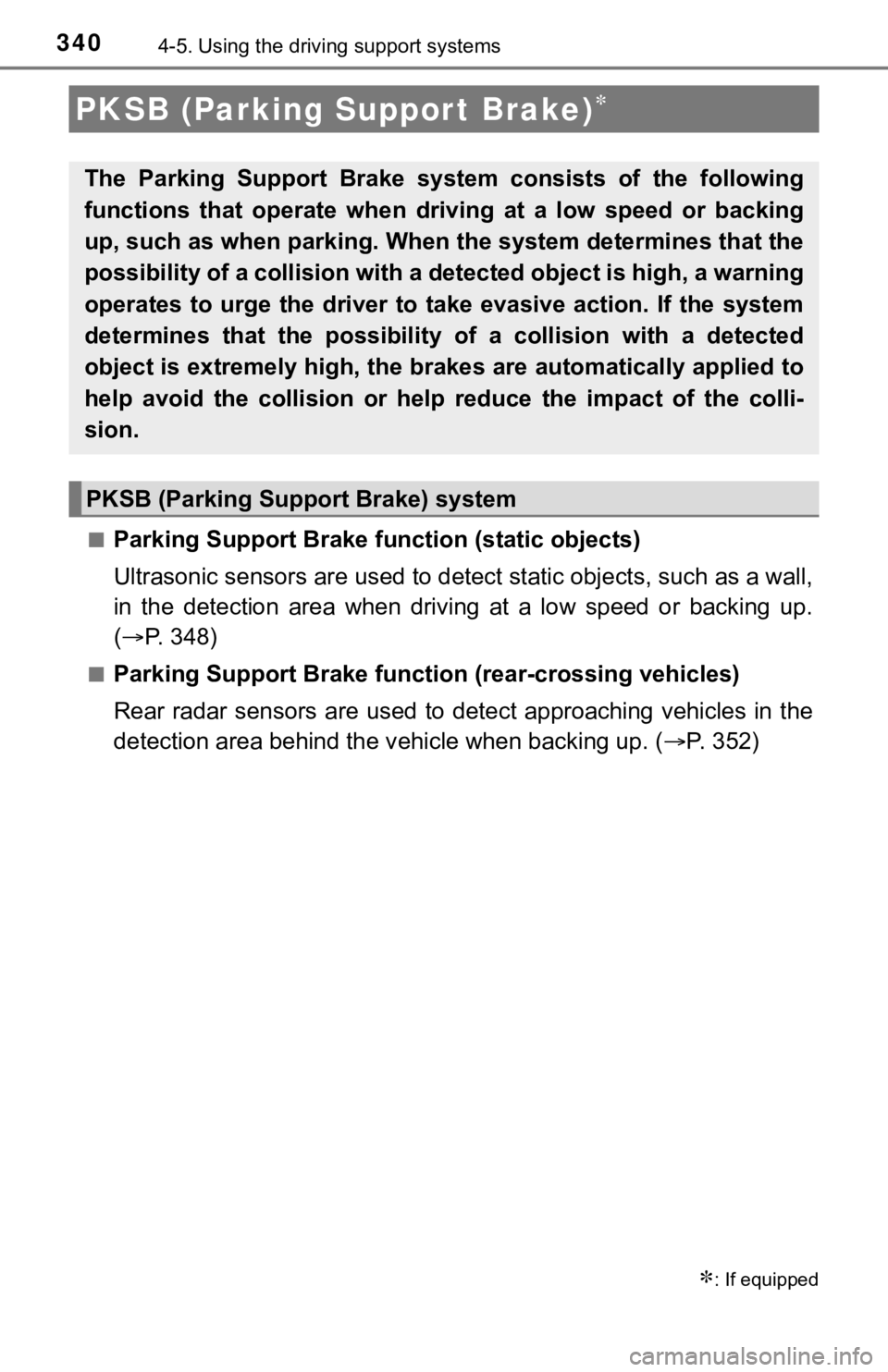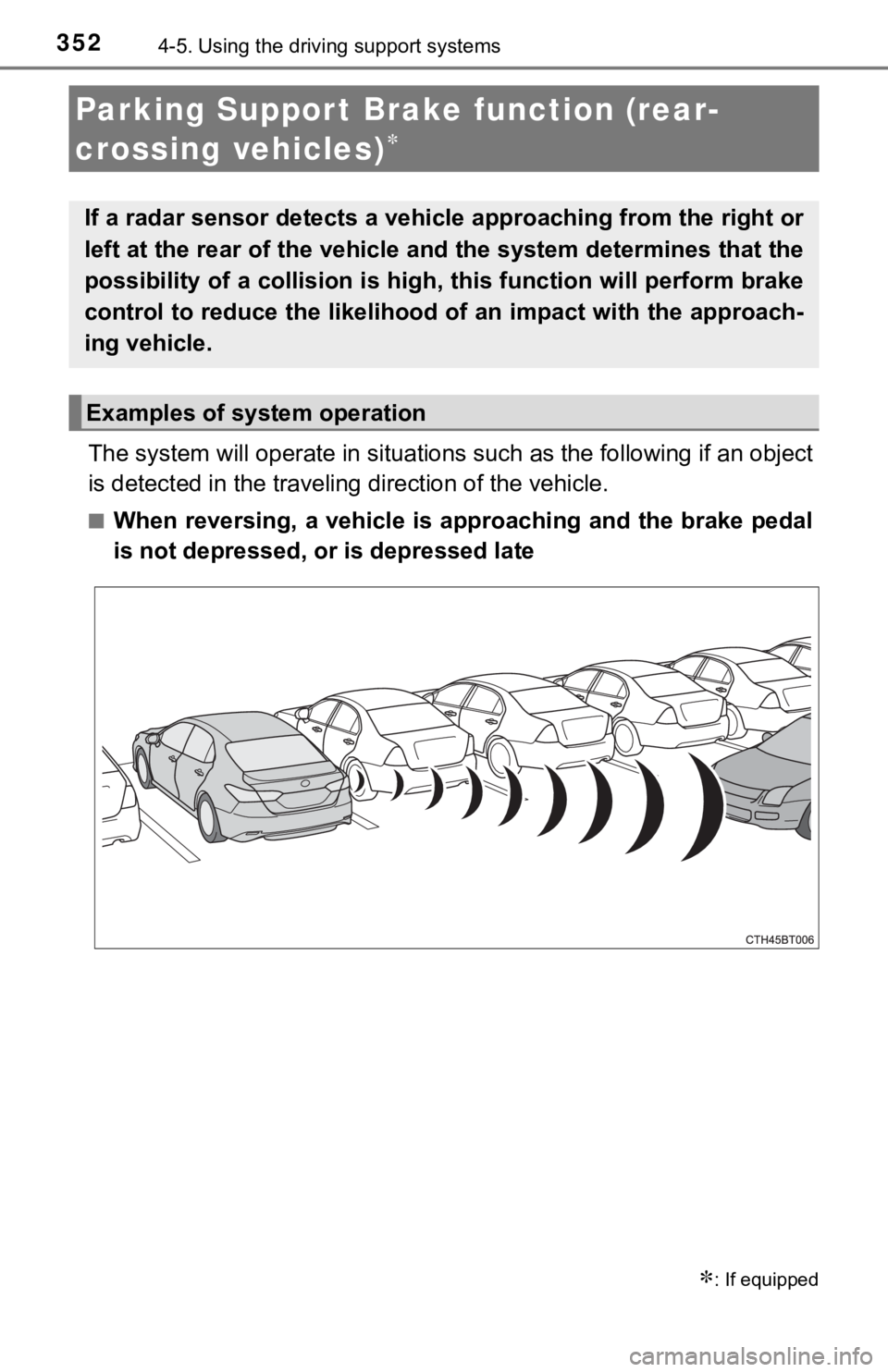sensor TOYOTA CAMRY HYBRID 2022 Workshop Manual
[x] Cancel search | Manufacturer: TOYOTA, Model Year: 2022, Model line: CAMRY HYBRID, Model: TOYOTA CAMRY HYBRID 2022Pages: 624, PDF Size: 13.76 MB
Page 340 of 624

3404-5. Using the driving support systems
■Parking Support Brake function (static objects)
Ultrasonic sensors are used to detect static objects, such as a wall,
in the detection area when driving at a low speed or backing up.
(P. 348)
■Parking Support Brake function (rear-crossing vehicles)
Rear radar sensors are used to detect approaching vehicles in the
detection area behind the vehicle when backing up. (P. 352)
PKSB (Parking Suppor t Brake)
: If equipped
The Parking Support Brake system consists of the following
functions that operate when driving at a low speed or backing
up, such as when parking. When the system determines that the
possibility of a collision with a detected object is high, a warning
operates to urge the driver to take evasive action. If the system
determines that the possibility of a collision with a detected
object is extremely high, the brakes are automatically applied to
help avoid the collision or help reduce the impact of the colli-
sion.
PKSB (Parking Support Brake) system
Page 341 of 624

3414-5. Using the driving support systems
4
Driving
Front corner sensors
Front center sensors
Rear corner sensors
Rear center sensors
The Parking Support Brake can be enabled/disabled on the multi-
information display. All of the Parking Support Brake functions (static
objects and rear-crossing vehicles) are enabled/disabled simultane-
ously.
Use the meter control switches to enable/disable the parking support
brake. (P. 109, 126)
Press
/ of the meter control switches, select .
Press
/ of the meter control switches, select .
Press of the meter control switch.
Select the “Yes” and push .
When the Parking Support Brake is disabled, the PKSB OFF indicator illu-
minates.
To re-enable the system when it was disabled, select on the multi-infor-
mation display, select and then “On”. If disabled using this method, the
system will not be re-enabled by turning the power switch off and then to
ON mode.
Types of sensors
1
2
3
4
Turning the Parking Support Brake on/off
1
2
3
4
Page 345 of 624

3454-5. Using the driving support systems
4
Driving
■If the Parking Support Brake function has operated
If the vehicle is stopped due to operation of the Parking Support Brake func-
tion, the Parking Support Brake system will be disabled and the PKSB OFF
indicator will illuminate. If the Parking Support Brake operates unnecessarily,
brake control can be canceled by depressing the brake pedal or waiting for
approximately 2 seconds for it to automatically be canceled. Then, the vehicle
can be operated by depressing the accelerator pedal.
■Re-enabling the Parking Support Brake system
To re-enable the Parking Support Brake system when it is disabled due to
operation of the Parking Support Brake function, either enable the system
again (P. 341), or turn the power switch off and then back to ON mode.
Additionally, if the object becomes no longer in the traveling direction of the
vehicle or if the traveling direction of the vehicle changes (such as changing
from moving forward to backing up, or from backing up to moving forward),
the system will be re-enabled automatically.
■If “PKSB Unavailable” and “Parking Assist Unavailable Clean Parking
Assist Sensor” are displayed on the multi-information display and the
PKSB OFF indicator is illuminating
●A sensor may be covered with ice, snow, dirt, etc. In this case, remove the
ice, snow, dirt, etc., from the sensor to return the system to normal. If this
message is shown even after removing dirt from the sensor, or shown when
the sensor was not dirty to begin with, have the vehicle inspected at your
Toyota dealer.
●A sensor may be frozen. Once the ice melts, the system will return to nor-
mal.
●Water may be continuously flowing over the sensor surface, such as in a
heavy rain. When the system determines that it is normal, the system will
return to normal.
Page 346 of 624

3464-5. Using the driving support systems
WARNING
■Cautions regarding the use of the system
Do not overly rely on the system, as doing so may lead to an accident.
Always drive while checking the safety of the surroundings of the vehicle.
Depending on the vehicle and road conditions, weather, etc., the system
may not operate.
The detection capabilities of sensors and radars are limited. Always drive
<005a004b004c004f004800030046004b00480046004e004c0051004a00030057004b0048000300560044004900480057005c00030052004900030057004b0048000300560058005500550052005800510047004c0051004a00560003005200490003005700
4b0048000300590048004b004c0046004f00480011[
●The driver is solely responsible for safe driving. Always drive carefully, tak-
ing care to observe your surroundings. The Parking Support Brake system
is designed to provide support to lessen the severity of collisions. How-
ever, it may not operate in some situations.
●The Parking Support Brake system is not designed to stop the vehicle
completely. Additionally, even if the system has stopped the vehicle, it is
<00510048004600480056005600440055005c0003005700520003004700480053005500480056005600030057004b00480003004500550044004e004800030053004800470044004f0003004c0050005000480047004c004400570048004f005c0003004400
560003004500550044004e0048000300460052005100570055[ol will be
canceled after approximately 2 seconds.
●It is extremely dangerous to check the system operations by intentionally
driving the vehicle into the direction of a wall, etc. Never attempt such
actions.
■When to disable the Parking Support Brake
In the following situations, disable the Parking Support Brake as the system
may operate even though there is no possibility of a collision.
●When inspecting the vehicle using a chassis roller, chassis dynamo or free
roller
●When loading the vehicle onto a boat, truck or other transport vessel
●If the suspension has been modified or tires of a size other than specified
are installed
●If the front of the vehicle is raised or lowered due to the carried load
●When equipment that may obstruct a sensor is installed, such as a towing
eyelet, bumper protector (an additional trim strip, etc.), bicycle carrier, or
snow plow
●When using automatic car washing devices
●If the vehicle cannot be driven in a stable manner, such as when the vehi-
cle has been in an accident or is malfunctioning
●When the vehicle is driven in a sporty manner or off-road
●When the tires are not properly inflated
●When the tires are very worn
●When a tire chains or compact spare tire is used
Page 347 of 624

3474-5. Using the driving support systems
4
Driving
NOTICE
■If “PKSB Unavailable” is displayed on the multi-information display
and the PKSB OFF indicator is illuminating
If this message is displayed immediately after the power switch is turned to
ON mode, operate the vehicle carefully, paying attention to your surround-
ings. It may be necessary to drive the vehicle for a certain amount of time
before the system returns to normal. (If the system is not return to normal
after driving for a while, clean the sensors and their surrounding area on the
bumpers.)
Page 348 of 624

3484-5. Using the driving support systems
The system will operate in situations such as the following if an object
is detected in the traveling direction of the vehicle.
■When traveling at a low speed and the brake pedal is not
depressed, or is depressed late
Parking Suppor t Brake function (static
objects)
: If equipped
If a collision with an object may occur due to the vehicle sud-
denly moving forward due to an accidental accelerator pedal
operation, the vehicle moving the unintended direction due to
the wrong shift position being selected, or while parking or trav-
eling at low speeds, the sensors detect objects, such as a wall,
in the traveling direction of the vehicle, and the system operates
to lessen an impact with an object and reduce the resulting dam-
age.
Examples of system operation
Page 352 of 624

3524-5. Using the driving support systems
The system will operate in situations such as the following if an object
is detected in the traveling direction of the vehicle.
■When reversing, a vehicle is approaching and the brake pedal
is not depressed, or is depressed late
Parking Suppor t Brake function (rear-
crossing vehicles)
: If equipped
If a radar sensor detects a vehicle approaching from the right or
left at the rear of the vehicle and the system determines that the
possibility of a collision is high, this function will perform brake
control to reduce the likelihood of an impact with the approach-
ing vehicle.
Examples of system operation
Page 448 of 624

4486-3. Do-it-yourself maintenance
◆Registering ID codes
Vehicles without a tire inflation pressure display function
Every tire pressure warning valve and transmitter has a unique ID
code. In addition to the set of tire pressure warning system sensor
ID codes initially registered to the vehicle, a second set of ID codes
can be registered.
A second set of tire pressure warning system sensor ID codes can
be registered at your Toyota dealer. When 2 sets of ID codes have
been registered, either ID code set can be selected.
Vehicles with a tire inflation pressure display function
Every tire pressure warning valve and transmitter has a unique ID
code. When replacing a tire pressure warning valve and transmitter,
it is necessary to register the ID codes.
The ID codes can be registered on (4.2-inch display) or (7-
inch display) of the multi-information display.
■Changing the available set of ID codes (vehicles without a tire
inflation pressure display function)
When 2 sets of ID codes are registered, the corresponding ID code
set for the installed wheels can be selected on (4.2-inch display)
or (7-inch display) of the multi-information display. It is not nec-
essary to reregister the ID codes each time the wheels are
changed.
For information regarding changing the registered ID codes for an
ID code set, contact your Toyota dealer.
■How to register the ID codes (vehicles with a tire inflation pres-
sure display function)
Park the vehicle in a safe place, wait for approximately 20 min-
utes, and then start the hybrid system. (P. 206)
Select (4.2-inch display) or (7-inch display) on the multi-
information display using the meter control switches on the steer-
ing wheel. (P. 109, 126)
4.2-inch display: Select “Vehicle Settings” and then press .
7-inch display: Select and then press and hold .
Select “TPWS” and then press .
1
2
3
4
Page 502 of 624

5027-2. Steps to take in an emergency
■SRS warning light
This warning light system monitors the airbag sensor assembly, front impact
sensors, side impact sensors (front door), side impact sensors (front), side
impact sensors (rear), driver’s seat position sensor, driver’s seat belt buckle
switch, front passenger occupant classification system (ECU and sensors),
“AIRBAG ON” indicator light, “AIRBAG OFF” indicator light, seat belt preten-
<0056004c00520051004800550056000f00030044004c005500450044004a0056000f0003004c00510057004800550046005200510051004800460057004c0051004a0003005a004c0055004c0051004a0003004400510047000300530052005a0048005500
03005600520058005500460048005600110003000b[P. 36)
■Front passenger detection sensor, seat belt reminder and warning
buzzer
●If luggage is placed on the front passenger seat, the front passenger detec-
tion sensor may cause the warning light to flash and the warning buzzer to
sound even if a passenger is not sitting in the seat.
●If a cushion is placed on the seat, the sensor may not detect a passenger,
and the warning light may not operate properly.
■If the malfunction indicator lamp comes on while driving
First check the following:
●Is the fuel tank empty?
If it is, fill the fuel tank immediately.
●Is the fuel tank cap loose?
If it is, tighten it securely.
The light will go off after several driving trips.
If the light does not go off even after several trips, contact your Toyota dealer
as soon as possible.
Page 511 of 624

5117-2. Steps to take in an emergency
7
When trouble arises
■If “Auto Power Off to Conserve Battery” is displayed
This message is displayed when the power was cut off due to the automatic
power off function.
The next time the hybrid system is started, keep the hybrid system operating
for approximately 5 minutes to recharge the 12-volt battery.
■If “A New Key has been Registered Contact Your Dealer for Details” is
displayed
This message will be displayed each time the driver’s door is opened when
the doors are unlocked from the outside for approximately one week after a
new electronic key has been registered.
If this message is displayed but you have not had a new electronic key regis-
tered, ask your Toyota dealer to check if an unknown electronic key (other
than those in your possession) has been registered.
■If “Headlight System Malfunction Visit Your Dealer” is displayed
The following systems may be malfunctioning. Have the vehicle inspected by
your Toyota dealer immediately.
●The LED headlight system
●The automatic headlight leveling system (if equipped)
●AHB (Automatic High Beam)
●AFS (Adaptive Front-lighting System) (if equipped)
■If “Radar Cruise Control Unavailable See Owner's Manual” is shown
The dynamic radar cruise control with full-speed range system is suspended
temporarily or until the problem shown in the message is resolved. (causes
and coping methods: P. 250)
■If “Radar Cruise Control Unavailable” is shown
The dynamic radar cruise control with full-speed range system cannot be
used temporarily. Use the system when it becomes available again.
■If a message that indicates the malfunction of front camera is displayed
The following systems may be suspended until the problem shown in the
message is resolved. (P. 250, 497)
●PCS (Pre-Collision System)
●LTA (Lane Tracing Assist)
●AHB (Automatic High Beam)
●RSA (Road Sign Assist) (if equipped)
●Dynamic radar cruise control with full-speed range
■If a message that indicates the malfunction of radar sensor is displayed
The following systems may be suspended until the problem shown in the
message is resolved. (P. 250, 497)
●PCS (Pre-Collision System)
●LTA (Lane Tracing Assist)
●Dynamic radar cruise control with full-speed range